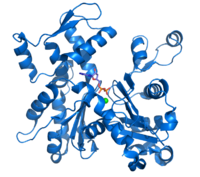
Photo from wikipedia
Dear Editor, Various types of intracellular inclusion bodies in plasma cells (PC), which mostly appear in the cytoplasm, have been described. The size and shape differ markedly, ranging from spherical… Click to show full abstract
Dear Editor, Various types of intracellular inclusion bodies in plasma cells (PC), which mostly appear in the cytoplasm, have been described. The size and shape differ markedly, ranging from spherical (Russell bodies, Mott cells, Dutcher bodies) [1, 2] to needle-shaped (Auer rod-like) or rectangular crystalline inclusions [2, 3] that may be found either dispersed in the cytoplasm or grouped in bundles. Intranuclear inclusions in PC, previously described as mainly spherical with varying number, size, and location within the nucleus, have rarely been reported in the literature [4–7]. In this case report, we describe the presence of uncommon bar-shaped intranuclear inclusions in the PC of a patient with light chain myeloma. A 73-year-old female was referred to a hospital for restaging of a kappa light chain monoclonal gammopathy of undetermined significance that has been diagnosed 4 years prior to admission. Laboratory evaluation showed a marked increase of the kappa free light chain (FLC) to 4070 mg/L (3.3–19.4) with a FLC ratio of 774, but no anemia, thrombocytopenia, hypercalcemia, or renal insufficiency. Bone marrow (BM) cytology revealed an infiltration of atypical PC showing singular bar-shaped/rectangular nuclear inclusions, causing a coffee bean–like appearance of the nuclei, in about 15% of the PC population (Fig. 1a). Other types of cytoplasmic or nuclear inclusions were not apparent. Overall, approximately 35 to 40% of the BM cellularity consisted of PC. By flow cytometric immunophenotyping, the PC were positive for CD138, CD38, and CD56 and negative for CD19, CD45, and IgG, −A, and −M heavy chains, and yielded a kappa light chain restriction. The histopathological and immunohistochemical examinations confirmed the presence of kappa light chain myeloma with the same morphological features as in BM cytology. The intranuclear inclusions failed to stain with hematoxylin and eosin (Fig. 1b), Giemsa (Fig. 1c), and PAS, but were stained dark blue with the INFORMkappa mRNA probe (VentanaMedical Systems, Roche, Germany), confirming the light chain content of the inclusions (Fig. 1d). In contrast to the well-known cytoplasmic inclusion bodies in PC, intranuclear inclusions are an uncommon morphological feature of PC that has rarely been reported in the literature. In these publications, the described intranuclear inclusions were mostly spherical and varied in number, size, and location within the nucleus [4, 7]. In accordance with the inclusions in the current case, these spherical inclusions failed to stain with hematoxylin and eosin, PAS, and Giemsa [4].
Journal Title: Annals of Hematology
Year Published: 2019
Link to full text (if available)
Share on Social Media: Sign Up to like & get
recommendations!